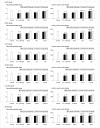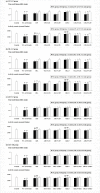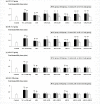Differential effects of TRPV1 receptor ligands against nicotine-induced depression-like behaviors
- PMID: 21767384
- PMCID: PMC3155896
- DOI: 10.1186/1471-2210-11-6
Differential effects of TRPV1 receptor ligands against nicotine-induced depression-like behaviors
Abstract
Background: The contributions of brain cannabinoid (CB) receptors, typically CB1 (CB type 1) receptors, to the behavioral effects of nicotine (NC) have been reported to involve brain transient receptor potential vanilloid 1 (TRPV1) receptors, and the activation of candidate endogenous TRPV1 ligands is expected to be therapeutically effective. In the present study, the effects of TRPV1 ligands with or without affinity for CB1 receptors were examined on NC-induced depression-like behavioral alterations in a mouse model in order to elucidate the "antidepressant-like" contributions of TRPV1 receptors against the NC-induced "depression" observed in various types of tobacco abuse.
Results: Repeated subcutaneous NC treatments (NC group: 0.3 mg/kg, 4 days), like repeated immobilization stress (IM) (IM group: 10 min, 4 days), caused depression-like behavioral alterations in both the forced swimming (reduced swimming behaviors) and the tail suspension (increased immobility times) tests, at the 2 h time point after the last treatment. In both NC and IM groups, the TRPV1 agonists capsaicin (CP) and olvanil (OL) administered intraperitoneally provided significant antidepressant-like attenuation against these behavioral alterations, whereas the TRPV1 antagonist capsazepine (CZ) did not attenuate any depression-like behaviors. Furthermore, the endogenous TRPV1-agonistic CB1 agonists anandamide (AEA) and N-arachidonyldopamine (NADA) did not have any antidepressant-like effects. Nevertheless, a synthetic "hybrid" agonist of CB1 and TRPV1 receptors, arvanil (AR), caused significant antidepressant-like effects. The antidepressant-like effects of CP and OL were antagonized by the TRPV1 antagonist CZ. However, the antidepressant-like effects of AR were not antagonized by either CZ or the CB1 antagonist AM 251 (AM).
Conclusions: The antidepressant-like effects of TRPV1 agonists shown in the present study suggest a characteristic involvement of TRPV1 receptors in NC-induced depression-like behaviors, similar to those caused by IM. The strong antidepressant-like effects of the potent TRPV1 plus CB1 agonist AR, which has been reported to cause part of its TRPV1-mimetic and cannabimimetic effects presumably via non-TRPV1 or non-CB1 mechanisms support a contribution from other sites of action which may play a therapeutically important role in the treatment of NC abuse.
Figures




References
-
- Warren CW, Lea V, Lee J, Jones NR, Asma S, McKenna M. Change in tobacco use among 13-15 year olds between 1999 and 2008: findings from the Global Youth Tobacco Survey. Glob Health Promot. 2009;16(Suppl 2):38–90. - PubMed
MeSH terms
Substances
LinkOut - more resources
Full Text Sources
Medical
Research Materials
Miscellaneous

